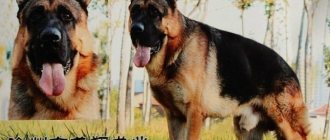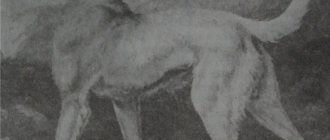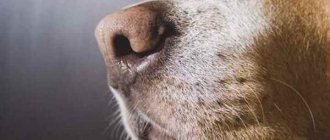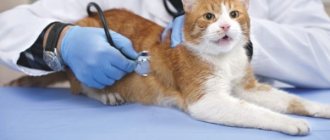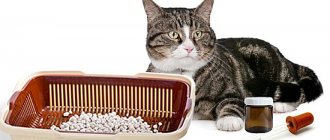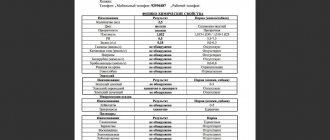Why does urinary incontinence occur in dogs after sterilization?
Urinary incontinence in dogs after sterilization cannot be called a mandatory consequence of such an operation, but this disorder occurs quite often. From a scientific point of view, it is regarded as a primary failure of the sphincter mechanism and is one of the most common forms of urinary incontinence in dogs. Problems with the toilet begin almost immediately after removal of the ovaries, although they can develop within three years, that is, a long time after surgery.
For this reason, a decrease in the level of sex hormones in the body—low estrogen levels—is considered the main reason for the development of pathology. In addition, the possibility of incontinence will depend on the time of the operation: the older the dog, the greater the likelihood of associated problems.
In addition to a decrease in estrogen levels, other likely causes of loss of urinary control after a dog is spayed include:
- decreased response of urethral receptors;
- abnormal position of the bladder and neck (their displacement from the abdominal cavity more to the pelvic cavity);
- anomalies and obesity of the vaginal vestibule area in females.
Each of these factors can manifest itself as a separate symptom, or can be combined with some other manifestations, as a result of which the likelihood of developing a problem only increases.
Important! Urinary incontinence can also occur after castration in male dogs, but this occurs much less frequently than in the case of female dogs. Treatment of the disorder will be longer, and its regimen should only be developed by a veterinarian.
Which dogs are predisposed to complications?
Urinary incontinence after neutering can develop in any dog, regardless of the breed or age of the animal. However, there is a list of breeds whose representatives, for unexplained reasons, suffer from the disorder more often than their relatives.
First of all this:
- Doberman pinschers;
- Labrador Retrievers;
- boxers;
- Rottweilers;
- Irish Setters;
- giant schnauzers;
- old English cattle dogs;
- Weimaraners;
- German shepherd dogs;
- English springerspaniels.
In addition, in comparison with outbred pets and mixed breeds of certain breeds, purebred dogs encounter this problem much more often. Representatives of small ornamental breeds are especially sensitive in this regard, since they freeze quickly and are prone to colds. True, their owners rarely undertake to sterilize them.
The essence of the procedure
Boy dogs tolerate the unpleasant procedure of “blocking male functions” more easily than girls. This happens because castration is a less traumatic intervention in the body than abdominal surgery (sterilization). In male dogs, the testicles are removed during the procedure. In a female dog, the veterinarian removes the uterus and ovaries (this method is called ovariohysterectomy). There is another option to deprive a bitch of her “femininity” - to eliminate only the ovaries, leaving the uterus in the body.
Veterinarians are convinced that it is much safer for a dog to lose all organs responsible for sexual functions. After all, if the ovaries are removed and the uterus remains, inflammation or tumor formation may develop in it over time.
The dog is sterilized under general anesthesia. To exclude the occurrence of an allergy to the drug, you can ask the veterinarian in advance to test the dog’s tolerance to the drug (the animal will be injected with a small amount of a sedative drug into the blood).
What are the symptoms of incontinence?
If the cause of sphincter weakness is the animal's past sterilization surgery, drops of urine will most likely appear during sleep or when the dog rests on its side. True, one should not exclude the possibility of fluid leakage at other times, especially while the animal is jogging or sitting.
Important! Do not confuse urinary incontinence with full urination in the wrong place. In the first case, the dog is not aware of what is happening, but the animal’s uncleanliness is a completely conscious phenomenon and requires correction in education.
The problem may disappear for a while, but then it still appears again, which is usually associated with changes in weather conditions outside or a change in the dog’s life rhythm. The owner can notice that something is wrong by looking at wet spots on the bedding, floor or furniture in the house, although the fur under the tail often remains wet.
Main symptoms
If a dog in the house involuntarily urinates, it may be accompanied by:
- Joy. Dogs love to wag their tail, jump up, or spin around in one place. This mainly happens at the sight of the owner.
- Frightened. If a dog is afraid of something, it squats on its hind legs or rolls over on its back.
- Site label. Some male dogs mark their territory when they smell another dog or hear barking. This shows their self-confidence.
- A demonstration of superiority. Young males who have not undergone training can show their superiority over their owner in this way.
Methods for treating urinary incontinence in dogs after sterilization
Treatment of urinary incontinence in dogs begins only after a complete examination of the pet and always taking into account the clinical picture of what is happening.
Typically, the treatment regimen is based on the following possible actions:
- Normalization of the animal's hormonal levels using medications.
- Direct administration of medicinal compounds into the walls of the bladder or urethra through endoscopic intervention through the wall of the abdominal cavity.
- Restoring muscle tone through suturing, collagen injection or surgical repositioning of the bladder (open abdominal surgery is performed).
The choice of a specific method of eliminating an existing disorder is selected taking into account the general condition and age of the animal.
With the help of drugs
Drug treatment of urinary dysfunction is considered a more gentle option for eliminating the problem, and alpha-adrenergic agonists are usually used as effective drugs. They stimulate the corresponding receptors in the internal sphincter of the dog's urethra, ensuring its complete closure. You can achieve a positive result regardless of the degree of neglect of the disease, the age of the pet and other factors.
Did you know? Dog nose prints are a lot like human fingerprints. There are no dogs with two identical noses, because the pattern of their surface is unique for each four-legged friend of man.
True, to achieve maximum treatment success, it is very important that the animal does not have heart failure, glaucoma, or kidney problems. Medicines with alpha-adrenergic agonists present in them contribute to an increase in blood pressure, which is also unacceptable for polyuria, cystitis and some other related bladder problems.
If problems with urinary control remain for a long time and become chronic, the animals are prescribed lifelong use of the drug “Propolin”. Its action is aimed at increasing the tone of the smooth muscles of the bladder and all urinary ducts, which in turn should normalize the functioning of the urethral sphincter. In most cases, this composition is well tolerated by the dog’s body, does not cause side effects and does not accumulate in the pet’s body.
According to the doctor's indications, other medications can be used: antidepressants (relax the walls of the organ, while simultaneously increasing the tone of its neck), antispasmodics and analgesics necessary to relieve associated symptoms and discomfort, even if they are not directly related to sterilization and castration.
Surgical intervention
The surgical method of eliminating the problem is usually based on the introduction of collagen into the periurethral area, thereby restoring the normal functioning of the urethral sphincter. The main disadvantage of this treatment is considered to be its relatively low effectiveness rate: around 40%, as well as the likelihood of the body rejecting the substance used, which requires its reuse.
Did you know? The tallest officially registered dog in the history of recent decades is deservedly considered a Great Dane named Zeus. His height at the withers was almost 112 cm, and so far no one has managed to break this record.
In developed veterinary clinics, with a full set of all necessary instruments and materials, it is possible to carry out colposuspension and perform various ring techniques. Compared to other surgical techniques, the endoscopic method of solving the problem with the introduction of collagen has significant advantages, since it allows visual inspection of the bladder neck, ureteral orifices and urethra. If necessary, the procedure can be repeated, with additional drug treatment.
Open abdominal surgery on the bladder to restore its tone is performed much less frequently than endoscopic intervention with the introduction of drugs into the tissue, but sometimes it cannot be avoided. Typically, such surgical treatment involves suturing the walls of the bladder, changing the position of the organ, targeted injection of collagen, and sewing in the ureters. Such radical measures are required when the walls of the bladder are damaged or severely weakened.
The process of normal urination
Urine is formed in the renal corpuscles, accumulates in the renal pelvis, and then travels to the bladder. The process is continuous and repeats every 20 seconds. Fluid accumulates and does not flow out of the bladder, being held by the sphincter.
As soon as the signal from the brain passes, the pet’s sphincter relaxes and urine flows out of the bladder. The process is repeated again with new filling.
Why does my dog have urinary incontinence?
Urinary incontinence in pets can occur due to several reasons. True incontinence. This is a situation where there is constant leakage or involuntary discharge.
- Emotional stress. With strong emotions (joy, fear), the animal makes a puddle.
- Natural uncleanliness. The dog was not trained in time and was not raised properly, so it simply does not know how to ask to go to the toilet correctly.
- Marker of nearby territory. This is inherent in nature and often animals that are not sterilized mark the space around them.
- Incontinence associated with aging animals. His reflexes are weakened.
- Intentional urination indoors. It is done to spite the owner for its own reasons, in order to annoy its owner.
- Urinary incontinence as a sign of pathology
Uncontrolled urination in dogs can be a sign of inflammation. It is imperative to use diagnostics to identify the causes of the disease. But the prerequisites for this phenomenon are difficult to identify, and even diagnosis occurs by exclusion.
In order to correctly diagnose the disease, you should explain to the doctor all the features of the dog’s diet, nutrition, and the events that happened to it. The more information the owner provides, the easier it will be to understand this pathology or temporary condition of the animal.
We recommend reading: Milbemax Koshek
Cystitis
To identify it, it is necessary to submit the animal’s urine for analysis. Often the cause of urine leakage is cystitis. If the inflammatory process is very strong, then the dog may have urinary incontinence during sleep.
Cystitis is caused by two main factors: severe cooling of the body and infection of the genitourinary system. It should be treated with a course of antibiotics; a noticeable improvement occurs on the 4th day after taking the medication. If there is no treatment, then urination begins with an admixture of blood, the dog whines in pain, and difficulties arise in excreting urine.
Advice : You should not drown out the symptoms by taking several tablets; you must complete the entire course of treatment.
If the inflammatory process is not completely cured, the disease returns in 60% of cases, and a repeated course of antibiotics does not give a good effective result.
Polydipsia
Due to constant thirst, the animal exceeds the amount of fluid consumed. In female dogs, this is a symptom in which the owner should urgently take the pet for an ultrasound. If treatment is not timely, the uterus may need to be removed. Do not self-medicate; take your dog to the veterinarian to prescribe treatment for your pet. Constant thirst in a dog often indicates the development of diabetes mellitus, serious problems with genitourinary function and blood vessels, and kidney problems.
Spinal injury
Urinary incontinence can occur due to pinched nerve fibers or spinal cord injury. The pain is poorly controlled and incontinence often depends on the anatomical structure of the dog. Dachshunds and other breeds with long spines often experience problems with bowel movements and incontinence after injury. This predisposition manifests itself especially strongly at the age when the dog grows old.
Pinched nerve endings
This phenomenon often occurs during or after childbirth. The dog's limbs become numb and painful. The bitch refuses puppies. Diagnosis of the disease occurs only after a comprehensive examination of the pet. There are several treatment options; in extreme cases, the doctor will prescribe surgery.
Nerve disorder
Occurs due to stressful situations, due to fear. Doctors recommend therapy with sedatives, which have a relaxing effect on the dog’s muscles.
Congenital pathologies
Incontinence may be a sign of ectopia. In this disease, the ureter is immediately connected to the intestine or vagina, and urine bypasses the bladder. Often seen in dogs born with one kidney. Usually detected at an early age. It can only be treated surgically.
Incontinence can be caused by weak urethral muscles. Pathology develops due to decreased sensitivity of the sphincter. In addition, excess weight, age of the pet, and hormonal medications can affect urinary incontinence.
Important : If there is constant wetness on the dog’s hind legs and under the tail, then it is necessary to urgently take the dog to a veterinary clinic.
Recovery prognosis
The prognosis for the success of treatment for urinary incontinence in dogs depends on many factors, but even with timely treatment, no veterinarian can guarantee complete relief from the problem. Surgery may only be 60–70% effective, but owners often have to give their dogs lifelong pills to control involuntary urination. The older the pet, the greater the chance of the disorder becoming chronic.
Find out why your dog drinks a lot and urinates often, the reasons and what to do about it.
Diagnosis of true incontinence
As already mentioned, urinary incontinence should be distinguished from behavioral and pathological urination. If the dog’s condition completely coincides with the symptoms described above, the veterinarian will prescribe a series of tests and tests. They will help determine the causes of the pathology and select treatment.
Most often, first of all, an ultrasound examination of the urinary organs is prescribed. This type of examination will help to exclude pathological urination. Of course, you can do urine tests, but these tests will not show pathologies such as neoplasms. At the same time, laboratory tests cannot be abandoned. Only with their help can infectious processes that can cause this condition be identified.
In addition to all of the above, a neurological examination of dogs should be performed to diagnose incontinence.
When determining pathology, conditions such as diabetes mellitus, cystitis, urolithiasis, oncological processes in the pelvis, endometritis, urethritis, and so on should be excluded.
How to return a dog to a full life?
Treatment for incontinence begins with determining the cause. In the event that the pathology is caused by a violation of the contractility of the sphincter, which more often occurs in obese or old dogs, hormonal drugs are used. The fact is that contractility is affected by the level of hormones in the body of pets. This is why the disease develops more often in castrated and sterilized animals.
If there are other reasons, drugs from the group of tricyclic antidepressants may be effective. Their action is aimed at relaxing the bladder muscles, but at the same time they cause sphincter contraction, which is required for urinary incontinence.
This is interesting: Treatment of the Prostate in Dogs
It should be noted that the drugs listed are potent and often cause various side effects. That is why they can only be used after consultation with a veterinarian and selection of the exact dosage.
Treatment of incontinence in the presence of injuries is discussed separately. Of course, if there is spinal damage involving the spinal cord, then returning such a dog to a full life will be especially difficult. In this case, incontinence can be cured only after the cause, that is, the consequence of the injury, has been eliminated.
As for young pets, you should know that the ability to control urination is formed at the age of 3-4 months. Moreover, this period directly depends on the owner’s ability to explain to the puppy where exactly he needs to relieve himself. At this age, true incontinence occurs in extremely rare cases and is caused by congenital pathologies of the urinary organs. Consequently, this condition can only be treated surgically.
In these two cases, the dogs understand what they are doing and can control the process. If there is incontinence, pets cannot resist the pathology, and the act of urination does not depend in any way on the dog’s desire.
